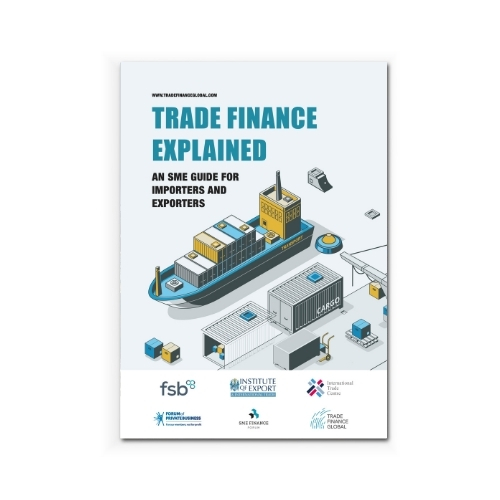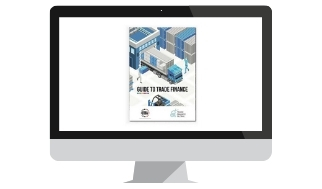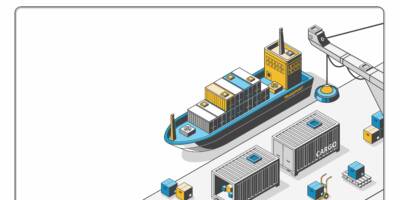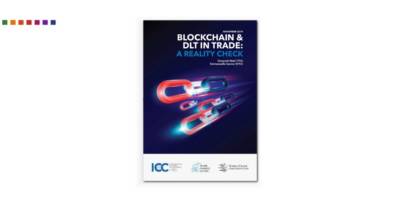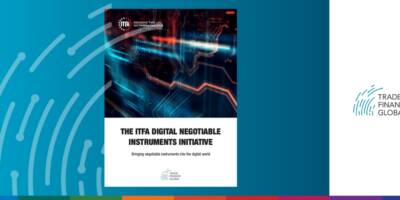Welcome to the SME trade finance guide.
This free SME trade finance guide, brought to you by Trade Finance Global and several industry partners, aims to help small and medium-sized enterprises (SMEs) learn about and access finance for importing and exporting goods.
So whether you’re a seasoned trader or a first-time importer or exporter, we hope this primer can help introduce you to the world of trade finance.
There are 550,000 exporting SMEs in the UK, with a potential contribution of up to £200bn to the UK’s economy (British Business Bank, February 2020). Information from ITCs UK Trade Partnerships Programme shows that emerging and developing economies trading with the UK, SMEs make up more than 70% of import supply chains. According to surveys by OECD, WTO & ITC, 74% of SMEs trading both goods and services say that access to affordable trade finance advances at the pre-invoicing stage is a top priority but also a major barrier to expanding exports. On the demand side, challenges lie around the lack of awareness of basic trade finance products. Many SMEs, on the other hand, do not think of themselves to be ‘international’ (despite having staff or assets abroad or trading in foreign currencies) and this is reflected in the quality of their preparations and financing applications.
The Covid-19 pandemic has exacerbated the challenges for SME access to trade and export finance as financing providers perceive a jump in supply chain disruptions and increased non-delivery and non-acceptance risks. However, in many countries supplying the UK, default risk on trade-related short-term financing remains relatively constant at around 2%[1] and trade in some sectors is at levels above those of the same period in 2019. This is why we are launching the Guide now.
The guide describes the main types of trade finance structures available to SME importers and exporters, outlines the methods of payment, risks and challenges, and shows how to access trade finance from various lending sources.
FSB Vice Chair Martin McTague said, “Around 20% of UK small businesses export to overseas markets. With the right support and tools, our research shows that this could increase to 40%. As we approach the end of the UK/EU transition period, and look to open up trade with new export markets around the world, small businesses don’t tend to know about trade finance and how it works.”
Mark Abrams, Director of Trade Finance, TFG, said: “We need to break down barriers, raise awareness and promote an understanding of how SMEs can expand their trade, and supply more goods and services cross-border.”
Ian Sayers, ITC’s Senior Adviser on Access to financing said: “Trade-related financing is well matched to SMEs current needs and business horizons, especially during COVID recovery when the future holds many uncertainties”
Sayers added: “For many years trade financing has been seen as the business of international buyers. It is time for SMEs to realize its potential to support a pivot into new markets, new certifications, expansion of the work force and sustainability improvements.”
What is trade finance?
Trade finance is the financing of goods or services in a trade or transaction, from a supplier through to the end buyer. It accounts for 3% of global trade, worth some $3 trillion annually.
‘Trade finance‘ is an umbrella term that includes a variety of financial instruments that an importer or exporter can use.
These include:
- purchase order finance,
- stock finance,
- structured commodity finance,
- invoice finance (discounting and factoring),
- supply chain finance,
- letters of credit (LCs), and
- bonds and guarantees.
The terms import finance and export finance are used interchangeably with trade finance.
In order to address some of the common issues and misunderstandings around trade finance, we have put together this short guide.
Download our free SME trade finance guide
What’s in the SME Trade Finance guide?
The guide describes the main types of trade finance structures available to SME importers and exporters, outlines the methods of payment, risks and challenges, and shows how to access trade finance from various lending sources.
- Why is trade finance necessary?
- Who benefits from trade finance?
- What are the main benefits of trade finance?
- Types of trade finance
- Methods of payment in trade finance
- Pre-shipment, post-shipment, and supply chain finance
- Risks and challenges in trade finance
- Types of trade finance lenders
- How to secure trade finance
- How to apply for a trade finance facility
Contribution Partners for this guide
Download our free SME trade finance guide
Frequently Asked Questions
Estimates indicate that 80-90% of global trade, worth approximately $10 trillion per year, relies on trade and supply chain finance.
This makes trade finance – which can also be referred to as supply chain finance, import finance, or export finance – a massive driver of economic development by helping to maintain the flow of credit in supply chains.
Many stakeholders, including corporates, SMEs, and governments, benefit from the added economic boost that comes from trade finance.
Companies use trade finance to increase the volumes of goods and services they trade, fulfil large contracts, and scale operations internationally.
Governments also assist with guaranteeing trade finance, as they aim to increase the trade of goods and services.
‘Trade finance’ is a catch-all term for the financing of international trade.
There are several different types, but these are generally categorised as:
- Trade credit
- Cash advances
- Purchase order (PO) finance
- Receivables discounting
- Term loans
- Other types of business finance
In this SME trade finance guide, we cover the four most popular types of payment methods: cash advances, letters of credit (LCs), documentary collections (DCs), and open account sales.
Each of these payment types introduces different levels of risk for the importer and the exporter.
When establishing a new relationship, buyers and sellers usually use intermediaries, such as banks, to limit risk, since the intermediaries can guarantee that payments are made on schedule.
As trust develops between a buyer and seller, businesses may switch to cash advances or provide trade credit on open account terms.
These latter methods, while introducing additional counterparty risk, reduce fees and create a faster and simpler payment environment.
As a business owner, it is important to understand the different risks of each type of payment method, to see which one is most favourable and suitable for your business requirements.
The COVID-19 pandemic has exacerbated the challenges for SME access to trade and export finance since financing providers perceive a jump in supply chain disruptions and increased non-delivery and non-acceptance risks.
However, in many countries supplying the UK, default risk on trade-related short-term financing remains relatively constant at around 2% and trade in some sectors is at levels above those of the same period in 2019.
Latest insights on types of trade finance
 Podcast | Short-term, self-liquidating, is trade finance as an asset class on the up? – At the ITFA annual conference in Abu Dhabi, TFG’s Mark Abrams spoke with Nishit Kumar, Senior Director, Head of Loan Syndications and Distribution at Mashreq Bank, and Kamola Burikhodjaeva, Executive Director, Head of Americas Distribution at J.P. Morgan.
Podcast | Short-term, self-liquidating, is trade finance as an asset class on the up? – At the ITFA annual conference in Abu Dhabi, TFG’s Mark Abrams spoke with Nishit Kumar, Senior Director, Head of Loan Syndications and Distribution at Mashreq Bank, and Kamola Burikhodjaeva, Executive Director, Head of Americas Distribution at J.P. Morgan.  Dani Cotti: 6 lessons from the tradetech industry – 2022 was a year of seismic and rapid changes for international trade and trade finance. War in Europe, COVID-19, and inflation created unimaginable disruptions in the industry. This dynamic phase is creating opportunities and gives way for new entrants in the ecosystem.
Dani Cotti: 6 lessons from the tradetech industry – 2022 was a year of seismic and rapid changes for international trade and trade finance. War in Europe, COVID-19, and inflation created unimaginable disruptions in the industry. This dynamic phase is creating opportunities and gives way for new entrants in the ecosystem.  DCW unveils its latest insights on letter of credit use in the USA – Following the latest Q3 2022 edition of its quarterly letter of credit (LC) statistics for US banks, Documentary Credit World (DCW) has released its analysis of LC issuance from banks in the country.
DCW unveils its latest insights on letter of credit use in the USA – Following the latest Q3 2022 edition of its quarterly letter of credit (LC) statistics for US banks, Documentary Credit World (DCW) has released its analysis of LC issuance from banks in the country.  Demand guarantees: let the courts decide – With the expanding use of economic sanctions within and across jurisdictions, lawyers have to consider not just the wording of the relevant economic sanctions but also how regulators will interpret whether certain activity is compliant or not and how courts will reach conclusions.
Demand guarantees: let the courts decide – With the expanding use of economic sanctions within and across jurisdictions, lawyers have to consider not just the wording of the relevant economic sanctions but also how regulators will interpret whether certain activity is compliant or not and how courts will reach conclusions. VIDEO | Landlocked but not alone: driving trade and development around the world – At the International Trade and Forfaiting Association’s (ITFA) 48th Annual International Trade and Forfaiting Conference in Porto, Trade Finance Global’s (TFG’s) Deepesh Patel sat down with Nelli Kocharyan, head of international relations and trade finance at Converse Bank, to discuss tactics to facilitate trade and development around the world.
VIDEO | Landlocked but not alone: driving trade and development around the world – At the International Trade and Forfaiting Association’s (ITFA) 48th Annual International Trade and Forfaiting Conference in Porto, Trade Finance Global’s (TFG’s) Deepesh Patel sat down with Nelli Kocharyan, head of international relations and trade finance at Converse Bank, to discuss tactics to facilitate trade and development around the world. VIDEO | Has asset management embraced trade finance and what more is left to be done? – Trade Finance Global (TFG) spoke with Jason Barrass, chief commercial officer at ARC Ratings to learn more about the role that credit rating agencies can play in this shift,
VIDEO | Has asset management embraced trade finance and what more is left to be done? – Trade Finance Global (TFG) spoke with Jason Barrass, chief commercial officer at ARC Ratings to learn more about the role that credit rating agencies can play in this shift, How can we help?
The TFG team works with the key decision-makers at 270+ banks, funds, and alternative lenders globally, assisting companies in accessing trade and receivables finance.
Our international team are here to help you scale up to take advantage of trade opportunities. We have product specialists, from machinery experts to soybean gurus.
Often the financing solution that is required can be complicated, and our job is to help you find the appropriate trade finance solutions for your SME.
Read more about Trade Finance Global and our global team.
Download our free SME trade finance guide
Download our free SME trade finance guide
Trade Finance Hub
1 | Introduction and the benefits
2 | Types of trade financing
3 | Methods of payment
4 | Pre and post-shipment finance
5 | Risks and challenges
6 | Trade and export finance providers
7 | The credit process and securing finance
8 | SME Trade Finance Guide
 Australia
Australia Hong Kong
Hong Kong Japan
Japan Singapore
Singapore United Arab Emirates
United Arab Emirates United States
United States France
France Germany
Germany Ireland
Ireland Netherlands
Netherlands United Kingdom
United Kingdom

